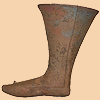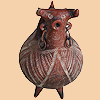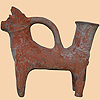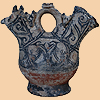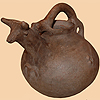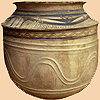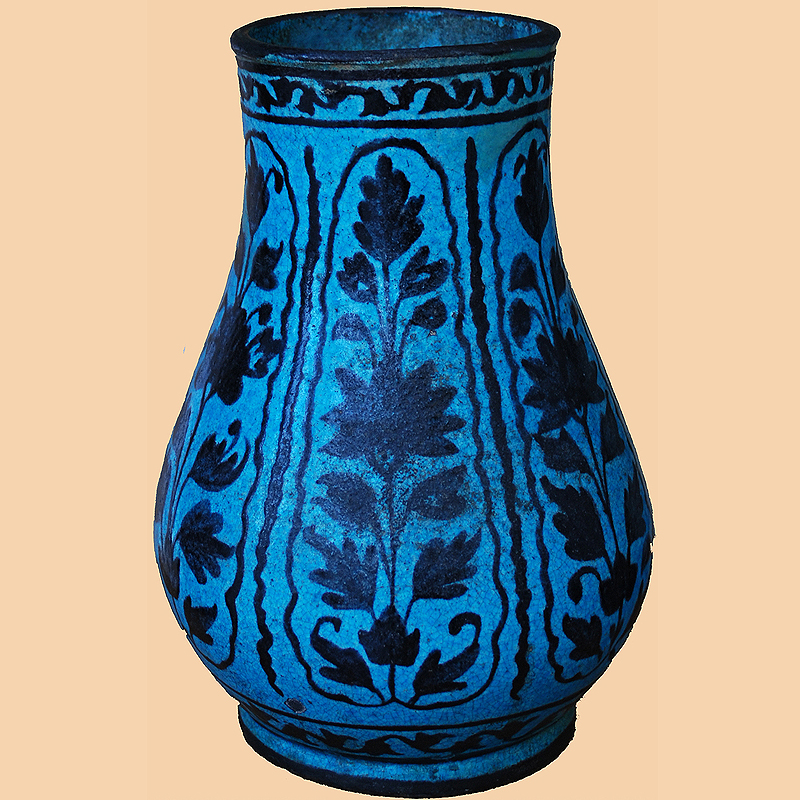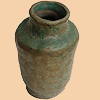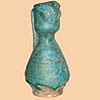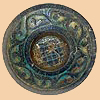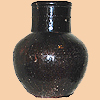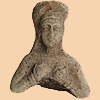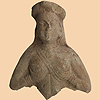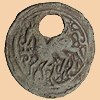 1 1
 2
2
 3
3
 4
4
 5
5
 Please visit the last pages for recent acquisitions
Please visit the last pages for recent acquisitions


|
 |
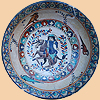
606
Seljuq Islamic Period Bowl with Prince on horseback Polychrome ceramics painted in a range of colors in a style similar to that found on manuscript illustrations became popular during the Seljuq period in Iran. The technique, known as mina'i("enameled"), involved a complicated double-firing process. Horsemen were favorite subjects in these works, but the comparative monumentality of the horse and of the princely Seljuq figure, which complement each other, makes this piece unusual. With its knotted tail, decorated bridle, curb bit, saddle, tassels, and rectangular blanket fastened by a breast band, the horse has a truly royal and ceremonial presence.
12th Century
Size 7" diam
Size 18cm
More Images Below
Provenance: From the Estate of Marion E James of Durham, NH. She Traveled to Persia and Middle East early 1950s to collect Ancient Artifacts
Below is History of Seljuq
|
 An Important Islamic Seljuq Bowl
An Important Islamic Seljuq Bowl
 |
 |
|
| |
|
|
|
History of Seljuq Pottery in Persia (Iran)
The Seljuqs, a Turkic dynasty of Central Asian nomadic origins, became the new rulers of the eastern Islamic lands following their defeat of the powerful Ghaznavids at the Battle of Dandanakan (1040). By 1055, the Seljuqs had reached and taken over Baghdad, which put an end to Buyid rule, and established themselves as the new protectors of the Abbasid caliphate and Sunni Islam. Within fifty years, the Seljuqs created a vast though relatively short-lived empire, encompassing all of Iran, Iraq, and much of Anatolia. By the close of the eleventh century, as the Seljuq realm became troubled due to internal conflicts and the division of the realm among heirs, the empire dissolved into separate territories governed by different branches of the dynasty. The main branch of the Seljuq house, the so-called Great Seljuqs, maintained control over Iran. Under the Seljuq sultanate, Iran enjoyed a period of material and cultural prosperity, and the ingenuity in architecture and the arts during this period had a notable impact on later artistic developments.The Seljuq cultural and artistic efflorescence continued well beyond the sultanate's political influence. In fact, as there are few surviving dated examples of Iranian art from the Seljuq period proper, works of art dating to the late twelfth and early thirteenth centuries are frequently labeled "Seljuq" even though they might have been produced under the patronage of one of several local dynasties. Turkic Seljuq rulers adopted and supported local Perso-Islamic traditions, and Seljuq art is recognized for weaving together Persian, Islamic, and Central Asian–Turkic elements. During this period, the arts of Iran gained distinction in the Islamic world.Important developments and innovations contributed to the renown of Seljuq art. Beginning in the second half of the twelfth century, the art of inlaying bronze or brass objects with precious metals such as copper, silver, and gold became prominent in the eastern Iranian province of Khorasan. Such objects were often decorated with Arabic inscriptionswritten in the "animated" script, developed during this period, in which the letters were transformed into human and animal figures. The same shapes known in metalwork were also produced in contemporary pottery. These ceramic wares demonstrate the advancement of new techniques or the further refinement of existing ones. Especially notable were the works produced in Kashan, in the luster and techniques. Also significant, though little known today due to few surviving examples, were the arts of the book.
The Seljuqs were also great patrons of architecture. An unprecedented number of madrasas (institutions of higher learning) were erected throughout the Seljuq realm. Most notable, however, was the Madrasa Nizamiya, founded in Baghdad by the great Seljuq vizier Nizam al-Mulk (r. 1063–92) to support Orthodox Sunni education (1067). In mosque architecture, the courtyard with four vaulted halls (iwans) on each side became prevalent. The transformed congregational mosque in Isfahan whose additions were commissioned by Nizam al-Mulk and Taj al-Mulk, two Seljuq administrators, for Sultan Malikshah (r. 1073–92) and his wife Terkan Khatun, was the most celebrated and influential Seljuq monument. Also important during this period were funerary monuments, the most prominent being the immense Mausoleum of Sultan Sanjar in Merv (r. ca. 1096–1157), in modern Turkmenistan.
|
|
